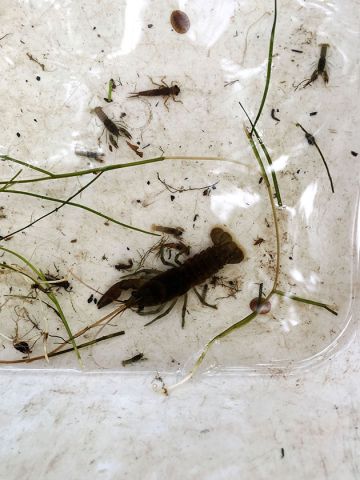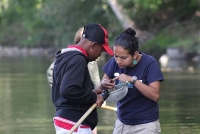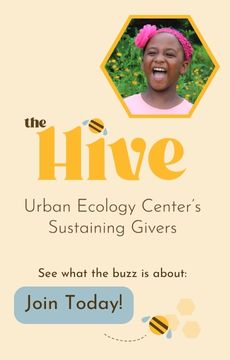When we arrived, the educators quickly ran through the expectations of the class.
Soon we struggled into giant rubber boots and waded into the river. The students shrieked with excitement, slipping and splashing while carrying nets and buckets. They overturned rocks, swept debris into the nets and picked out the tiny insects – aquatic macroinvertebrates – that appeared there. Some students were eager to touch the small larvae and crayfish, but others needed some encouragement. All around me I saw total engagement, teamwork and confidence replacing fear.
After lunch we learned how to recognize the creatures in our buckets and the students carefully documented their finds. They used a key to identify dragonfly larvae, mayfly larvae, leeches and more. A class favorite was the gigantic cranefly larvae which was over an inch long and treaded the line between fascinating and gross.

Life in the river. Photo: Sarina Counard-Ryals
Toward the end of the program we tallied the number and variety of each species and used this to formally rate the quality of the water, which we found to be on the upper edge of “fair”. Earlier in the year, this class had done an identical study of the same river at Hubbard Park in Milwaukee where we had found that the diversity of species was much lower. This lead to a discussion about what factors may have impacted this, from farming to factories to weather. The kids were engaging in scientific thought as well as more critical thoughts about how humans and water are interconnected. This is the heart of this program and I could tell that these students had really grasped it.
Before our hike out of the woods, the teacher gathered the students and had them stand in a silent circle, placing their hands on their hearts and taking five deep breaths. He invited them to look around the flower-filled forest and get in touch with how it felt to be there. The students were calm and silent, listening to bird calls and the sound of the river.
These fifth graders had been kindergarteners when I started working as an educator at the Urban Ecology Center and this last trip together was rewarding and a little bittersweet. I was grateful to spend the day with them learning, exploring, and connecting.





